I went on a coastal adventure in Europe looking for the greenest beaches. My first stop was Nissi Beach in Cyprus. It’s a 500-meter stretch of paradise with the Blue Flag award. The sand was soft, and the waters were crystal clear.
I kept exploring, finding more green beaches. Wales’ Saundersfoot Beach and Malta’s Mellieha Beach were breathtaking. Each beach showed me how beautiful nature can be.
What amazed me was the number of Blue Flag beaches in Europe. Spain had 629, and Greece had 625. Italy, France, and Croatia also had many, showing their dedication to green tourism.
Thinking back, I feel hopeful for Europe’s eco-friendly beaches. These places are not just beautiful but also teach us how to care for our coastlines. They show us how to enjoy the beach while protecting it for the future.
Key Takeaways
- Europe has many eco-friendly beach destinations, with Spain leading in Blue Flag certifications.
- Sustainable beaches focus on conservation and responsible tourism.
- Blue Flag status means a beach is clean and well-protected.
- Many European countries, like Greece and Portugal, offer safe and green coastal experiences.
- Eco-conscious travelers have lots of sustainable beach options in Europe.
Introduction to Sustainable Coastal Tourism
I’ve seen a big change in travel: more people want to visit eco-friendly beaches. It’s exciting to see this move towards green coastal tourism. It’s not just about enjoying the beach. It’s about keeping it beautiful for others in the future.
The Rise of Eco-Conscious Beach Travel
More people are choosing eco-friendly beach trips. They want vacations that don’t harm the environment. This change is because of big problems like ocean acid and rising sea levels.
Benefits of Choosing Green Beach Destinations
Choosing green beaches has many benefits. These places are cleaner and have healthier ecosystems. By supporting these areas, we help protect nature. We also get to experience local cultures in a more authentic way.
How to Identify Environmentally Friendly Shorelines
Finding eco-friendly beaches takes some effort. Look for beaches with the Blue Flag, a sign of eco-friendliness. Also, check if they have local conservation efforts. Beaches without plastic are a good sign too.
Some key signs of eco-friendly beaches include:
- Effective waste management systems
- Protected marine life zones
- Use of renewable energy sources
- Sustainable transportation options
- Community-led conservation initiatives
By picking these places, we can enjoy the beach and help the planet.
| Indicator | Sustainable Beach | Non-Sustainable Beach |
|---|---|---|
| Waste Management | Recycling bins, regular clean-ups | Overflowing trash cans, litter on sand |
| Marine Life | Protected areas, educational programs | Unregulated fishing, disturbed habitats |
| Energy Use | Solar-powered facilities | High electricity consumption |
| Local Community | Involved in conservation efforts | Minimal engagement in beach upkeep |
| Water Quality | Regularly monitored, crystal clear | Polluted, not tested frequently |
The Azores: Europe’s Best Sustainable Destination
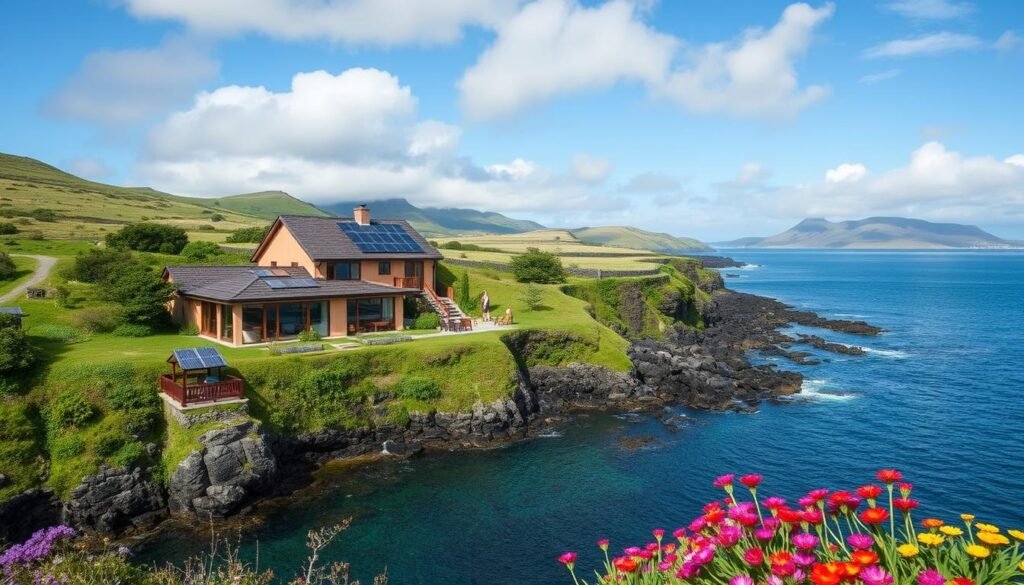
I found a hidden treasure in the Atlantic Ocean – the Azores. This nine-island group is Europe’s Best Sustainable Destination for 2025. It’s the world’s first archipelago to get certified by the EarthCheck Sustainable Destination program.
The Azores government, local community, and tourism partners work together. They aim to keep culture and ecosystems safe. They use new ways to save water and energy, winning awards like Europe’s Responsible Tourism Award 2021.
I saw many eco resorts during my visit. Places like Aqua – Pópulo Eco Village and Santa Bárbara Eco-Beach Resort. They are green but still comfy.
“The Azores offer a perfect blend of luxury and environmental consciousness, making it a top choice for eco-conscious travelers.”
The islands have clean beaches and safe wildlife. This makes them great for eco-friendly fun. I tried walking tours, stand-up paddling, and wine tasting. The Azores has something for everyone, from solo travelers to those looking for luxury.
| Sustainable Feature | Description |
|---|---|
| Renewable Energy | Geothermal, solar, wind, and hydroelectric power |
| Eco-Resorts | Aqua – Pópulo Eco Village, Santa Bárbara Eco-Beach Resort |
| Green Activities | Hiking, cycling, whale watching |
| Conservation Efforts | Protected marine ecosystems, wildlife preservation |
The Azores is a top example of green tourism in Europe. It’s beautiful and cares for the environment. It’s a place where eco-conscious travelers can have amazing experiences.
Eco-Friendly Beaches in Europe: A Comprehensive Guide
I’ve explored some of Europe’s most stunning eco-friendly beaches. Each offers unique experiences while focusing on conservation. These places show how natural beauty and sustainable practices can go hand in hand.
Gerakas, Greece: Turtle Conservation Paradise
Gerakas Beach is a turtle haven in Zakynthos National Marine Park. It protects endangered loggerhead sea turtles during nesting season. Visitors can enjoy the pristine shores while learning about turtle preservation.
Duboka Bay, Croatia: Luxury Meets Sustainability
Duboka Bay is known for its eco-luxe approach. It features villas powered by solar energy. This shows that luxury and green practices can go together.
Agave Village, Albania: Pioneering Eco-Tourism
Agave Village is a leader in sustainable tourism. It uses rainwater harvesting and solar energy to reduce its impact. Guests can enjoy organic food from local farms, supporting the community and environment.
Bibione, Italy: Smoke-Free and Dog-Friendly
Bibione is a smoke-free beach for health-conscious travelers and pet lovers. It also has electric vehicle charging stations. This shows its commitment to green certifications.
Las Islas Cies, Spain: Pristine Nature Reserve
Las Islas Cies is a nature reserve with effective conservation. It limits daily visitors to 2,200 to keep its beauty intact. This makes it a prime example of sustainable tourism.
| Beach | Country | Key Eco-Feature |
|---|---|---|
| Gerakas | Greece | Turtle conservation |
| Duboka Bay | Croatia | Solar-powered villas |
| Agave Village | Albania | Rainwater harvesting |
| Bibione | Italy | Smoke-free, EV charging |
| Las Islas Cies | Spain | Visitor number limits |
Blue Flag Beaches: Hallmarks of Sustainability
Blue Flag beaches are at the forefront of low impact tourism in Europe. They are clean, safe, and easy to get to. This makes them great for those who want to travel in a way that’s good for the planet.
Spain has the most Blue Flag beaches with 628. Greece follows with 596. Italy and France have 457 and 403 beaches, respectively. Portugal has 394, rounding out the top five. This shows a big push towards sustainable coastal tourism.

The Blue Flag program checks water quality, safety, visitor services, and environmental education. This matches well with tips for sustainable travel. It teaches visitors to care for these beautiful places.
Now, let’s look at some amazing Blue Flag beaches:
- Cala San Vicent, Ibiza: A family-friendly semicircular beach with golden sand
- Cala Llenya, Ibiza: A wide bay surrounded by pine trees, ideal for eco hotels
- Es Canar, Ibiza: Lively atmosphere perfect for water sports enthusiasts
- Es Figueral, Ibiza: Calm waters great for swimming and snorkeling
These beaches are not just beautiful. They also help with reforestation and sustainable practices. By visiting Blue Flag beaches, I support eco-friendly tourism. This helps keep these coastal wonders safe for the future.
| Country | Number of Blue Flag Beaches |
|---|---|
| Spain | 628 |
| Greece | 596 |
| Turkey | 551 |
| Italy | 457 |
| France | 403 |
Castiglione della Pescaia: Italy’s Eco-Friendliest Beach Resort

I found a hidden gem in Italy’s coastal paradise. Castiglione della Pescaia is a charming Tuscan town. It’s Italy’s eco-friendliest beach resort. It’s loved by locals for its natural beauty and sustainable tourism.
Conservation Efforts and “Cinque Vele” Award
Castiglione della Pescaia is dedicated to marine conservation. It has the “Cinque Vele” (Five Sails) award. This award shows its commitment to protecting its natural habitat.
Eco-Education for Visitors
The resort teaches visitors about eco-friendly tourism. I learned about waste reduction and local produce. Since 2019, it’s a #plasticfree zone, setting an example for others.
Sustainable Activities: Hiking and Cycling
Castiglione della Pescaia offers sustainable activities. I hiked in nature reserves and cycled along the coast. These activities let visitors enjoy the area while being eco-friendly.
| Award | Achievement | Year |
|---|---|---|
| Blue Flag | 23 consecutive years | 2022 |
| Cinque Vele | 3rd place in “Most beautiful seaside” guide | 2022 |
| Spighe Verdi | Sustainable rural development | 4 consecutive years |
| FIAB Yellow Flag | Bicycle-friendly initiatives | 2022 |
Castiglione della Pescaia’s commitment to sustainability is strong. It’s part of the Cetacean Sanctuary and the G20 Italian Beaches network. It shows how local communities can thrive while protecting the environment.
Sustainable Practices at European Beach Destinations
I’ve found that European beach spots are at the forefront of being green. Many resorts now run on solar power, cutting down on carbon emissions. It’s amazing to see how these places are going green.
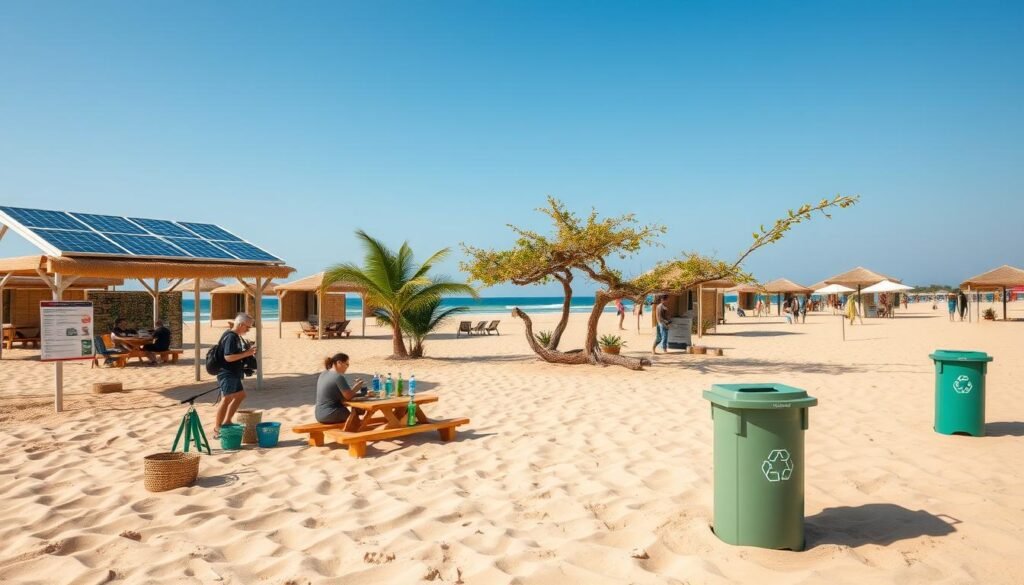
Community-led tourism is growing in Europe’s coastal areas. Local folks are working hard to keep their beaches clean and offer special experiences to visitors. This helps the environment and boosts the local economy.
For those looking for green vacations, there are many volunteer travel options. I’ve seen that many beach resorts have programs for tourists to help clean beaches or watch wildlife. It’s a wonderful way to help out while on holiday.
“Over half of Tripadvisor’s users consider helping the environment important, impacting their travel decisions.”
Reusing waste is a big deal for many European beaches. I’ve seen projects where plastic is turned into art or beach furniture. It’s a creative way to fight marine pollution.
European beaches are setting the bar high for being eco-friendly. Seven out of the top ten most sustainable beaches on Tripadvisor are in Europe. Places like Sandbanks Beach in the UK and Galissas Beach in Greece show that tourism and protecting the environment can work together.
- Denmark aims to be carbon neutral by 2025
- Norway promotes electric ferries in its fjords
- Sweden boasts eco-certified hotels
- Finland focuses on low-impact activities like forest bathing
- Iceland relies on renewable geothermal and hydroelectric energy
These green efforts are not just good for the planet. They’re also drawing in travelers who care about the environment. It’s clear that the future of beach tourism in Europe is all about being green and sustainable.
Impact of Eco-Tourism on Local Communities and Economies
Eco-friendly tourism is changing coastal economies in Europe. I’ve seen how it helps both visitors and locals. Now, Europe’s clean beaches are centers for green projects that help local businesses and protect nature.
Supporting Local Produce and Businesses
In many beach towns, eco-markets are popping up everywhere. Tourists love to buy fresh food, handmade items, and local specialties. This helps local economies and cuts down on carbon emissions by reducing travel.
Community-Led Tourism Initiatives
Communities are leading their own tourism efforts. I’ve joined tours led by locals who share their culture and history. These tours make sure tourism money goes straight to the people, boosting their pride and sense of ownership.
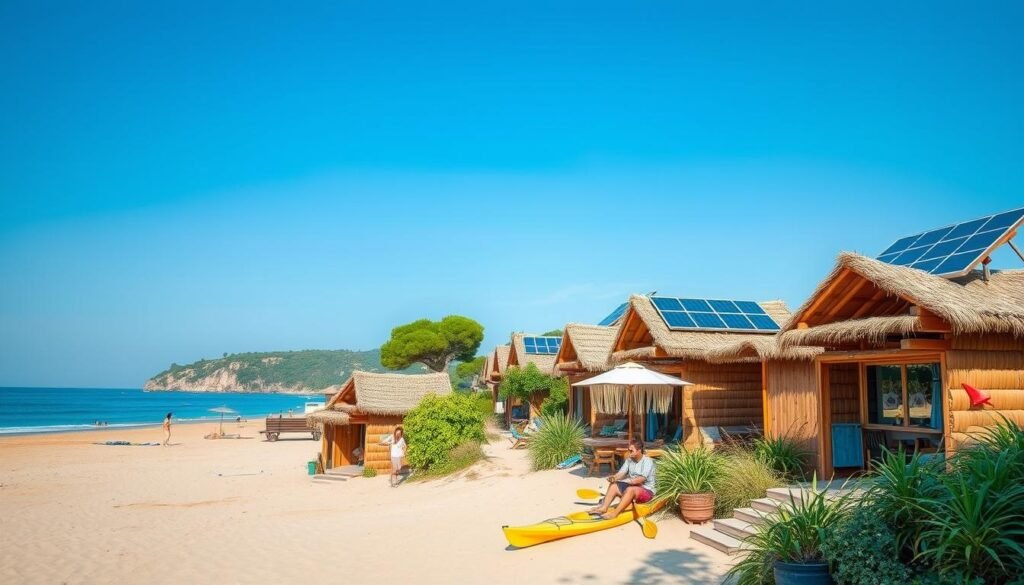
Balancing Tourism and Environmental Protection
Keeping beaches clean is key for beach destinations. I’ve seen places limit visitors to protect their ecosystems. This way, tourists can enjoy the beaches while keeping marine life safe.
| Eco-Tourism Impact | Benefits | Challenges |
|---|---|---|
| Local Economy | Job creation, increased income | Seasonal fluctuations |
| Environment | Conservation efforts, reduced pollution | Managing tourist footprint |
| Culture | Preservation of traditions | Potential commercialization |
Sustainable travel is changing Europe’s coastlines. By supporting local projects and following environmental rules, we can make sure these places stay beautiful for future generations.
Tips for Eco-Friendly Beach Vacations in Europe
I’m excited to share my top tips for responsible beach travel in Europe. These suggestions will help you enjoy your vacation while supporting marine environment protection and eco-friendly tourism.
First, choose certified sustainable accommodations. Look for eco-lodges or hotels with green certifications. In Croatia’s Duboka Bay, I stayed in a solar-powered villa that was both luxurious and environmentally friendly.
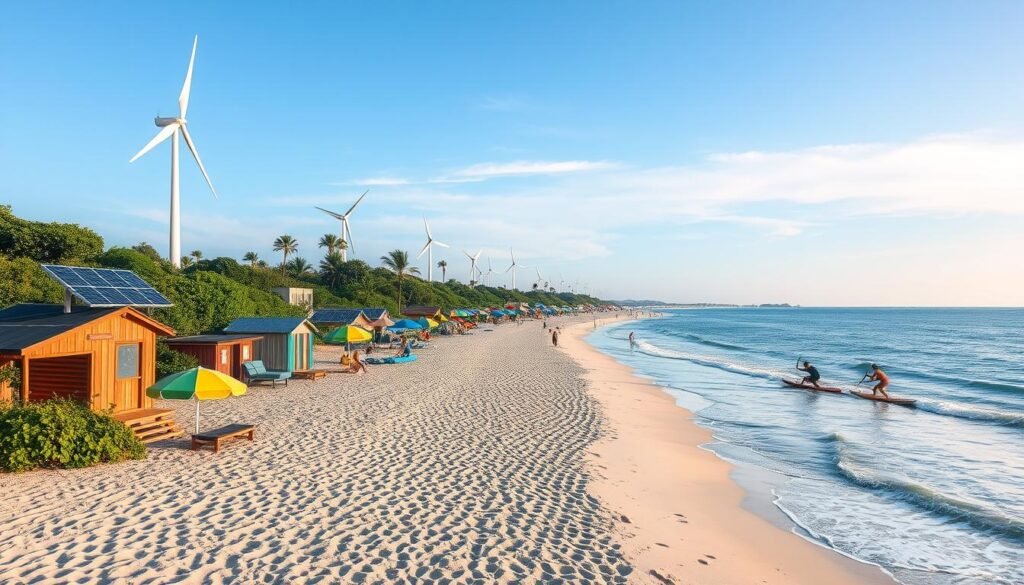
When packing, don’t forget reef-safe sunscreen. Traditional sunscreens can harm marine life, so opt for mineral-based options. I always bring a reusable water bottle and shopping bag to reduce plastic waste.
Support local conservation efforts during your stay. In Gerakas, Greece, I participated in a sea turtle protection program. It was an incredible experience that deepened my appreciation for marine life.
- Use public transportation or rent bicycles to explore
- Eat at local restaurants that serve sustainable seafood
- Respect wildlife habitats and nesting areas
- Practice proper waste management – leave no trace!
Consider visiting during off-peak times to reduce your environmental impact. For example, the best time to visit the Azores for eco-friendly tourism is from April to October. This timing allows you to enjoy pleasant weather while avoiding the busiest tourist season.
By following these tips, we can all contribute to preserving Europe’s beautiful beaches for future generations while enjoying unforgettable vacations.
Conclusion
I’ve looked into Europe’s eco-friendly beaches and I’m impressed. These places show how we can travel green and help nature. From the Azores to the Mediterranean, each spot is beautiful and cares for the environment.
The EU really cares about the environment. During EU Green Week, over 5,300 people joined online events. And 80,000 people took part in 44 countries. It’s good to know 83% of EU beaches have excellent water quality.
The Blue Flag program has over 4,800 beaches worldwide. It sets high standards for coastal tourism. I’m inspired by efforts like the Junior Achievement Hackathon, where students fight beach pollution.
It’s clear that eco-friendly beach vacations in Europe are here to stay. By choosing these places, we help keep Europe’s coasts beautiful for the future.

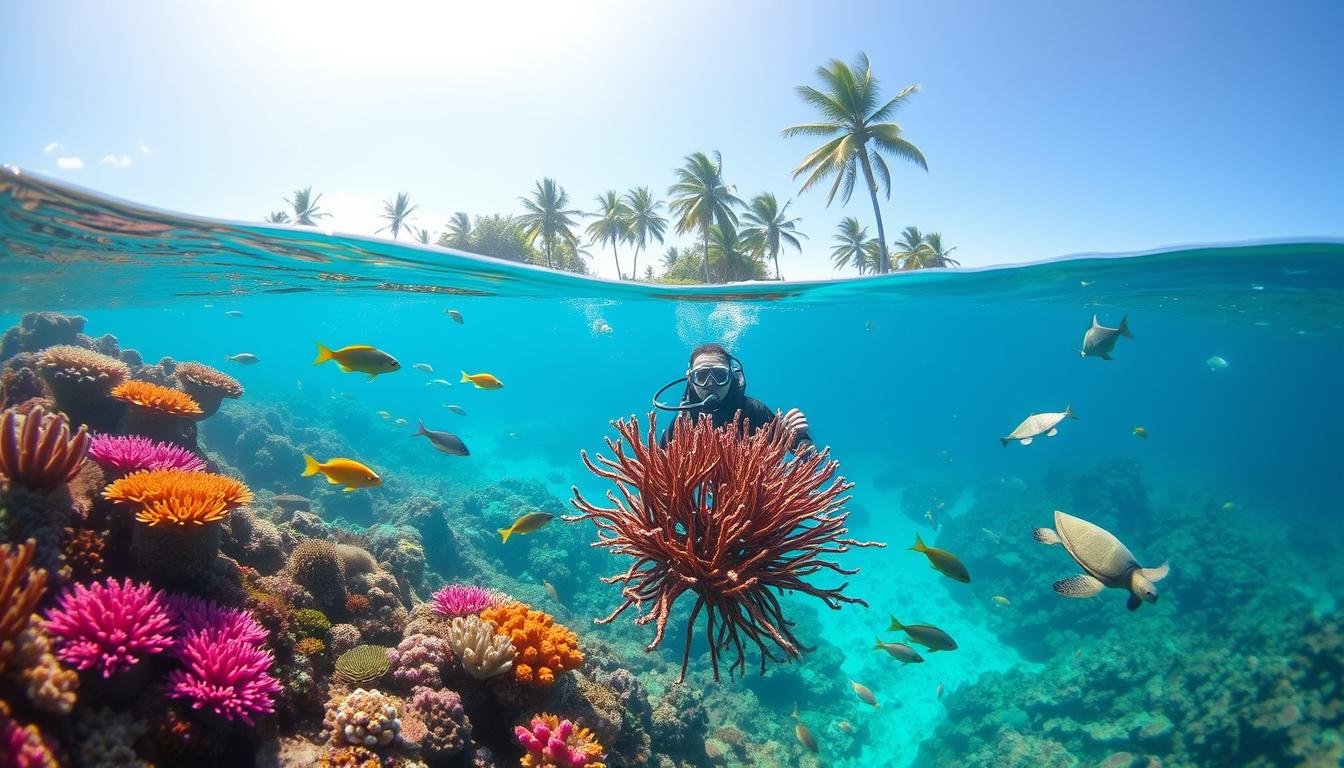
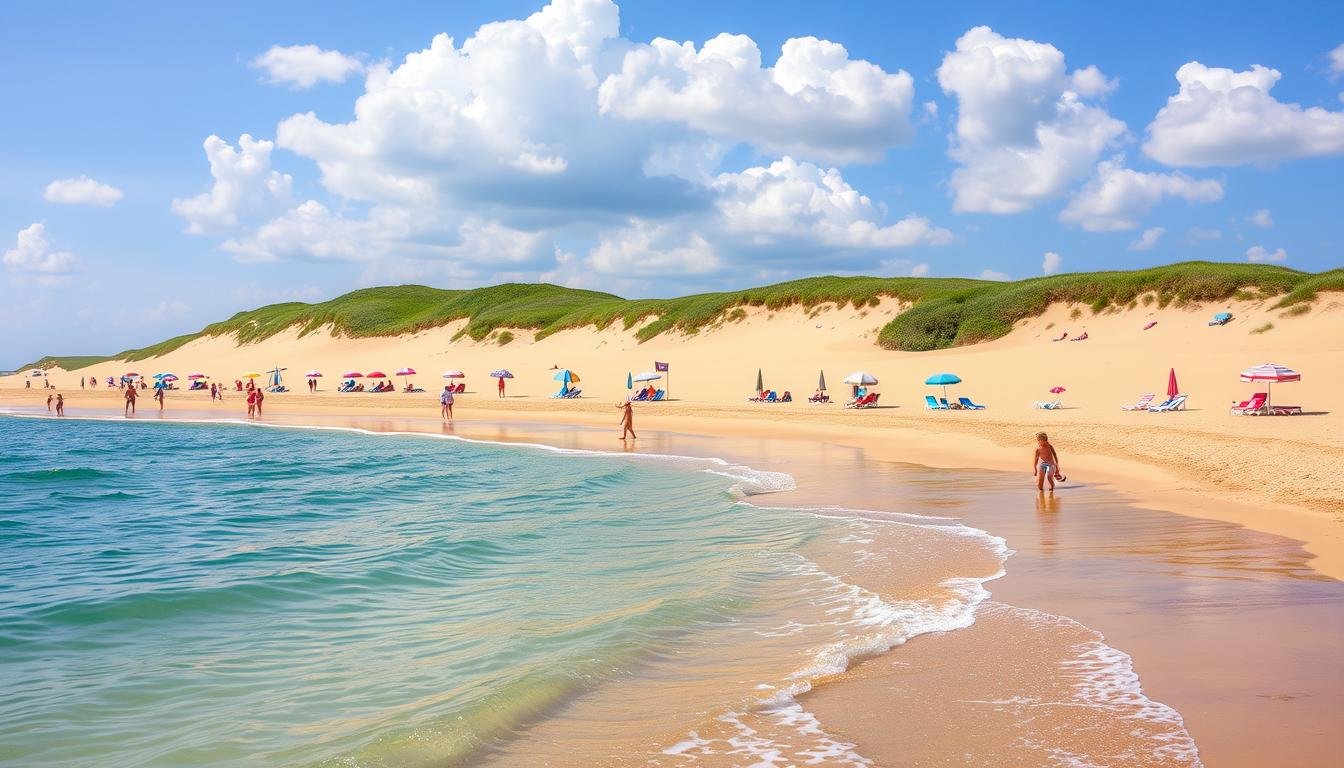
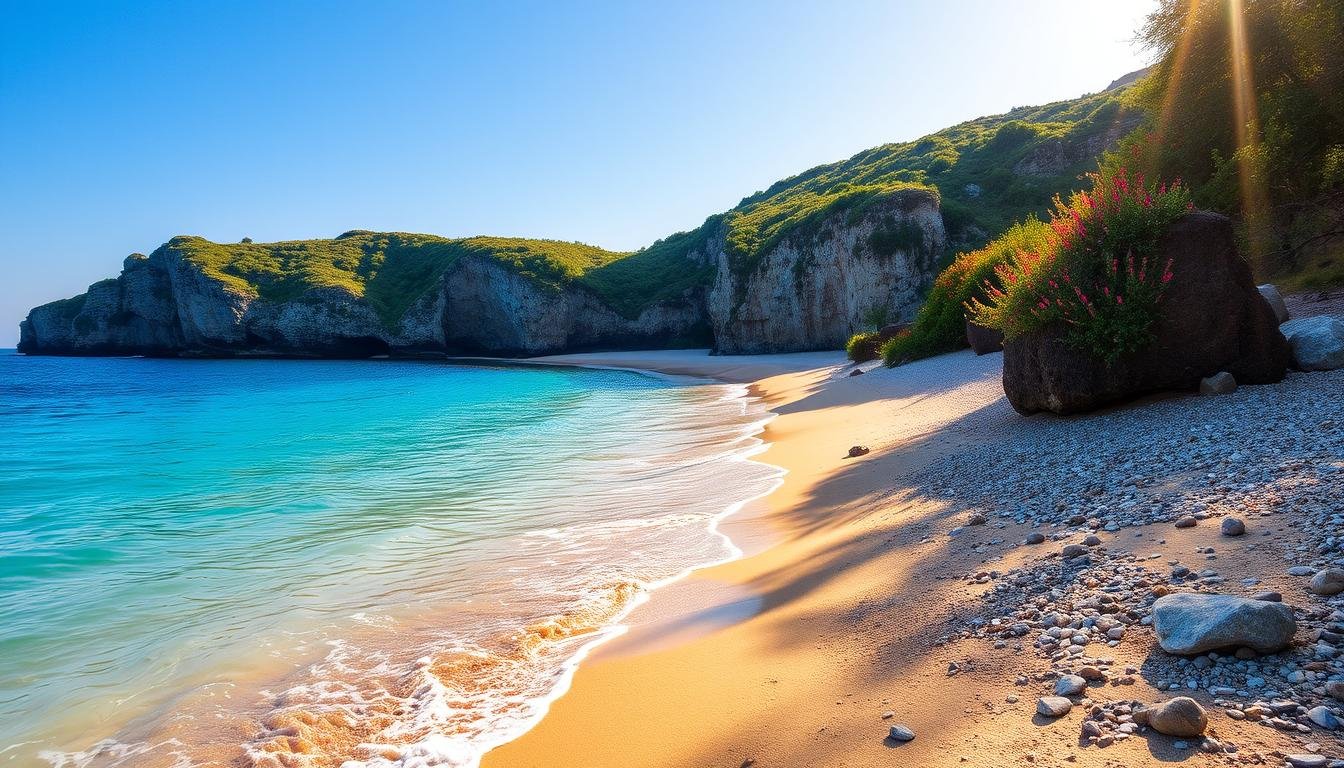
Leave a Reply